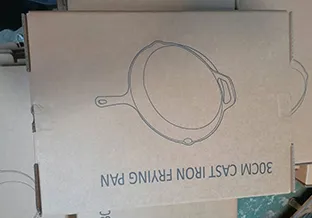
cast skillet
Exploring the Art of Cast Iron Skillets A Timeless Culinary Tool
When it comes to versatile kitchen tools, few can rival the cast iron skillet. For centuries, this simple yet effective cooking instrument has been a staple in kitchens around the world. Whether you're sautéing vegetables, searing meats, or baking cornbread, a cast iron skillet can handle it all, providing an even cooking surface and retaining heat like no other pan. In this article, we'll explore the history, benefits, care, and culinary applications of cast iron skillets, illustrating why they remain beloved by both home cooks and professional chefs alike.
A Historical Perspective
The origins of cast iron cookware date back to ancient China, around the 5th century BC. The material gained popularity in Europe during the Middle Ages, with cast iron skillets becoming a common household item by the 18th century. Their durability and ability to retain heat made them essential for cooking, particularly over open flames. Cast iron skillets were not merely cooking vessels; they were seen as heirlooms that could be passed down through generations. Today, brands like Lodge and Le Creuset continue this legacy, producing skillets that marry traditional craftsmanship with modern performance.
The Benefits of Using Cast Iron Skillets
One of the primary advantages of cast iron skillets is their incredible heat retention and distribution. Unlike some materials that cool down quickly when food is added, cast iron skillets maintain a consistent temperature, allowing for even cooking. This characteristic is particularly beneficial when searing meat, as it helps achieve that perfect caramelized crust while keeping the inside juicy and tender.
Another benefit is the natural non-stick surface that develops over time through a process called seasoning. When properly cared for, a cast iron skillet can provide a non-stick cooking surface without the need for synthetic coatings, which can sometimes release harmful chemicals at high temperatures. Additionally, cooking with cast iron can boost your dietary iron intake, as small amounts of iron can leach into food during the cooking process.
Caring for Your Cast Iron Skillet
cast skillet

To ensure your cast iron skillet lasts for generations, proper care is essential. Unlike other cookware, cast iron requires a specific maintenance routine, starting with regular seasoning. After each use, it is ideal to clean the skillet with a stiff brush or non-metal scrubber and minimal soap, followed by drying it immediately to prevent rust. To maintain its non-stick surface, a thin layer of oil should be applied throughout the cooking surface after cleaning.
If your skillet becomes rusty or loses its seasoning, don't despair; it can be restored. A simple technique involves scrubbing the skillet with steel wool to remove rust, followed by re-seasoning it in the oven. With patience and diligence, you can maintain your skillet's functionality for years to come.
Culinary Applications
The versatility of cast iron skillets is unmatched. From traditional dishes like cornbread and fried chicken to modern recipes such as shakshuka or frittatas, the cast iron skillet can adapt to various culinary traditions. You can use it on the stovetop for sautéing, in the oven for baking, or even over a campfire for an authentic outdoor cooking experience.
One popular recipe that highlights the skillet's adaptability is a classic cast iron skillet pizza. With a quick homemade dough or store-bought, you can create a crispy crust topped with your choice of ingredients, cooked to perfection in a matter of minutes. The skillet’s ability to produce excellent heat retention ensures that your pizza will have a crispy bottom while keeping the toppings bubbling and delicious.
Conclusion
In a world of rapidly evolving kitchen gadgets and non-stick pans, the cast iron skillet stands the test of time. Its blend of historical significance, practical benefits, and culinary versatility make it a must-have for anyone who enjoys cooking. With proper care and a little bit of love, your cast iron skillet can become a cherished tool in your kitchen, one that not only prepares meals but tells a story of tradition and craftsmanship. So, whether you’re a novice cook or a seasoned chef, consider reaching for that cast iron skillet the next time you’re in the kitchen—you won’t regret it!
-
Season Cast Iron Perfectly with GPT-4 Turbo TipsNewsAug.01,2025
-
High Quality Cast Iron Cookware - Baixiang County Zhongda MachineryNewsAug.01,2025
-
Premium Cast Iron Pan: Durable & Perfect HeatNewsAug.01,2025
-
High Quality Kitchen Durable Black Round Cast Iron Cookware Pancake Crepe Pan-Baixiang County Zhongda Machinery Manufacturing Co., Ltd.NewsAug.01,2025
-
Cast Iron Cookware - Baixiang County Zhongda Machinery | Nonstick, Heat ResistanceNewsAug.01,2025
-
High Quality Kitchen Durable Black Round Cast Iron Cookware - Baixiang County Zhongda Machinery | Non-Stick, Heat Retention, DurableNewsJul.31,2025


